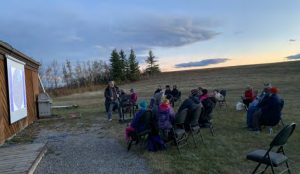Dark Skies in the Foothills
Roland Dechesne,
Foothills Dark Sky Committee
Have you ever wondered what’s up with those Dark Sky Country signs in the north part of Foothills County? Did you know that there’s a group of people who collaborate on protecting the natural dark night skies in defense against the pressures of Calgary urbanization?

One of the things that makes Foothills County special is that despite abutting one of the country’s largest cities, there is a rural feel to the County. With all the pressures for development, protecting what country residents like about their lifestyles doesn’t come easily. Through Foothills County council and staff collaborating with interested citizens, and stakeholders such as the Ann & Sandy Cross Conservation Area, the University of Calgary’s Rothney Astrophysical Observatory and the Calgary Centre of the Royal Astronomical Society of Canada and their observatory, also in the County, best practices for nighttime lighting are discussed and implemented. These people also celebrate the natural dark skies of Foothills County through educational events. Watch for upcoming events celebrating International Dark Sky Week, April 22-30.
Dark skies are vital to astronomy and the research conducted at the Rothney Astrophysical Observatory. But we also recognize the value of dark skies to all life on earth and closer to home the rural lifestyle of people in the Foothills County. We are celebrating Dark Sky Week on April 22nd to 30th with our first public event on Saturday April 23. This is an opportunity for us to share how incredible it is to spend time out of doors to observe the spring constellations.
While we all need some light at night, it turns out that much lighting is poorly designed and installed or installed in an attempt to improve a situation but actually makes that situation worse. For example, within a home we often consider ‘task lighting’ where a carefully shielded light source illuminates a particular area, such as a desk, or a set of stairs. Inside, we strive to find fixtures that direct the light to the target and don’t create glare; after all, who would want to live in a house that looks like a used car lot? The same mindset should be applied to outdoor lighting. Instead, we commonly find unshielded lights on poles, or wall-mounted fixtures that spray light as far as possible, creating glare. Glare always reduces visibility.
Some of these lights were installed to increase visibility for the home or business owners when working around the yard at night and these lights increase safety because everything becomes visible, including tripping hazards. But some of these lights were installed by home or business owners in an attempt to increase ‘security’, to reduce nighttime crime, but these lights actually reduce security and can lead to an increase in nighttime crime because everything becomes visible, including valuables. It’s as if you supplied a table full of free flashlights and expected nighttime crime to go down. In studies that measured crimes throughout a 24 hour period, it appears that nighttime illumination shifts some of the daytime crime into the nighttime hours.
People often imitate what they see others do, so do your best to set a good example. You may want to stand on your own property and look back toward your house to be sure that your lights are not offensive to your neighbors. Lights need to be shrouded and aimed in such a way that the neighbors won’t be bothered, but also so that you don’t inadvertently create glare and reduce your own visibility. Illuminating your home with soft landscape lighting can also make your home feel well lit without needing large powerful flood lights that shine out onto streets or neighbor’s windows.
Top Tips for Improving Lighting Quality
- Decide whether a light is needed at all. Sometimes the best solution is to not create more issues with bad lighting.
- Is lighting appropriate for the locale? Natural areas shouldn’t be illuminated. Nighttime light can also legitimize the presence of strangers.
- Use minimal light, pick the lowest lumens required for the situation.
- Choose amber lamps instead of bluish ones. There’s less environmental impact, and blue light triggers the eye’s glare response.
- Choose when to light. Timers, dimmers and motion sensor lights reduce light pollution.
- Keep light aimed to the target. Don’t attempt to ‘throw’ light too far, or waste it by shining above the horizontal. If you can see the bulb, it’s not right.


























